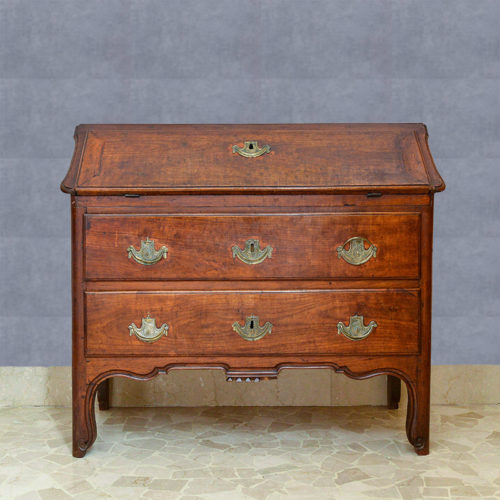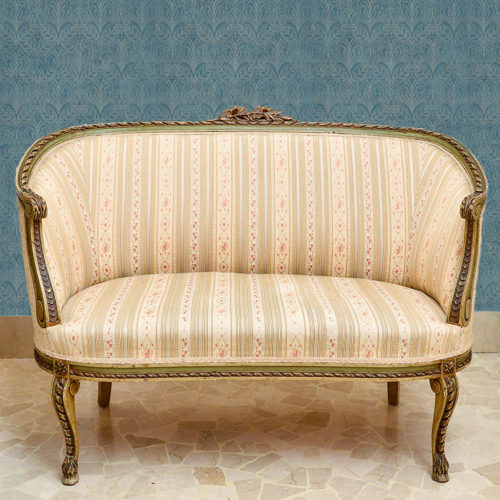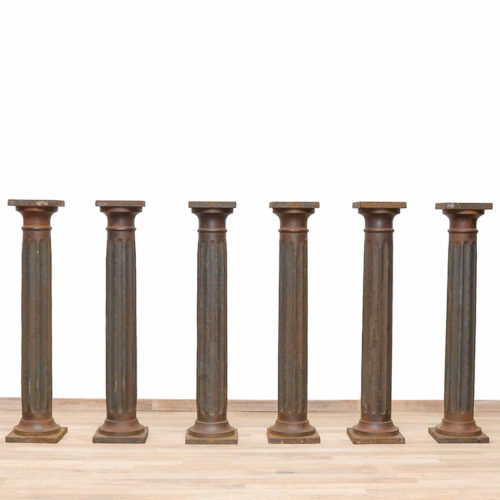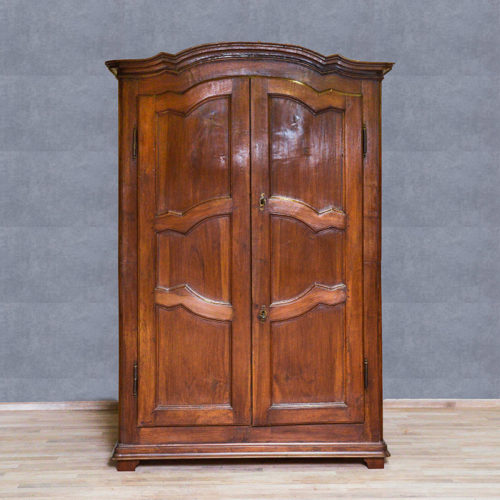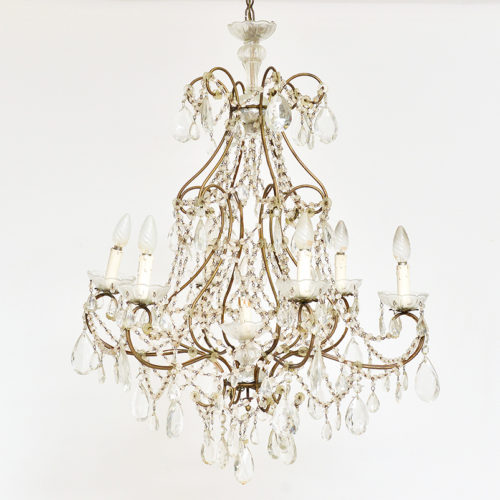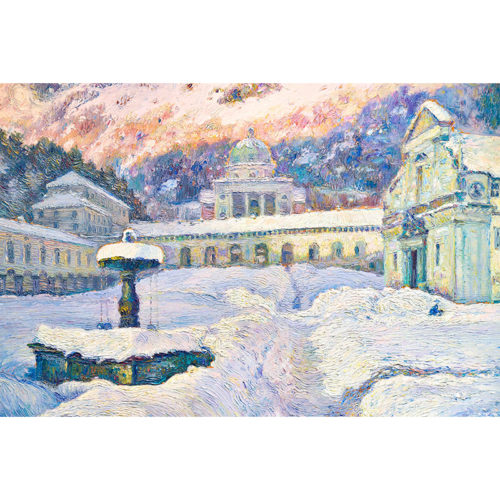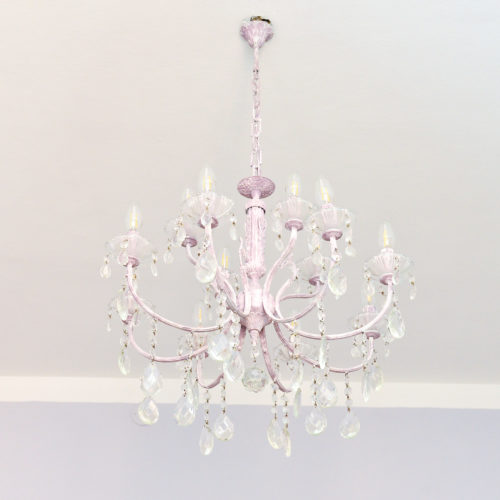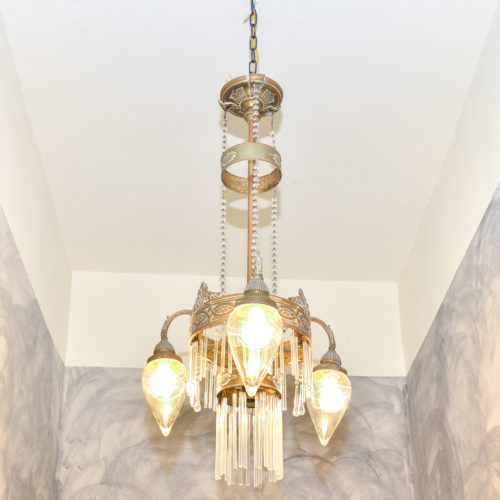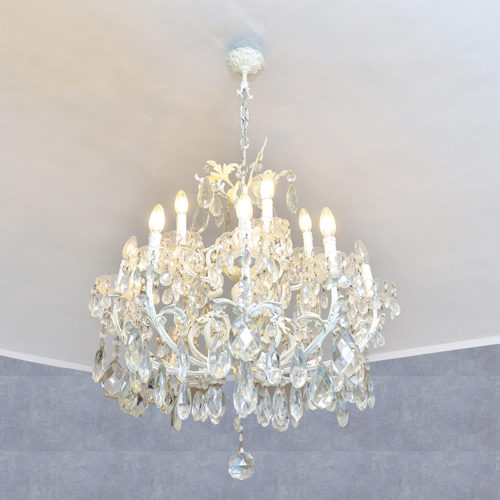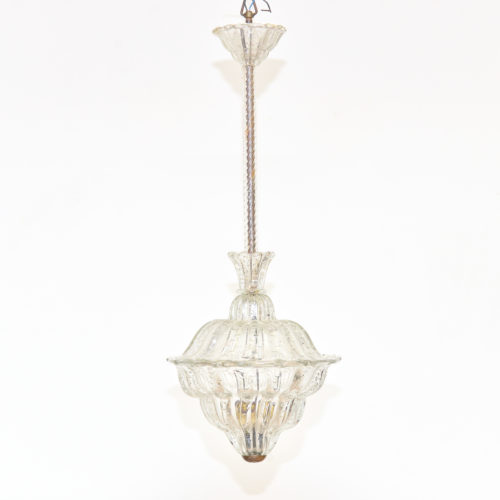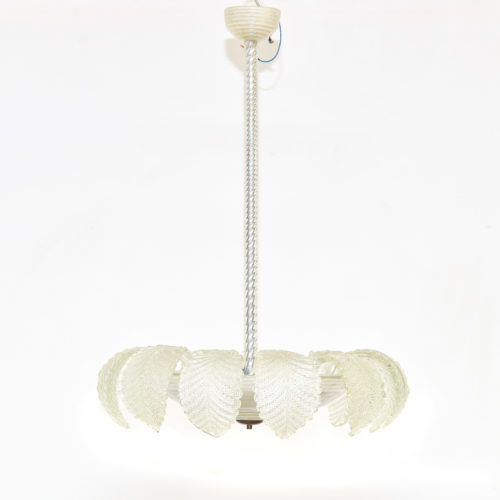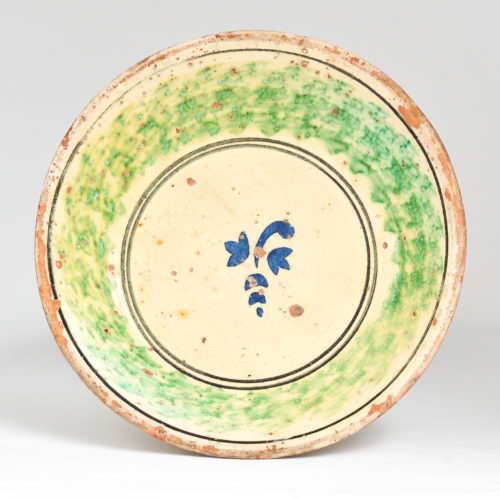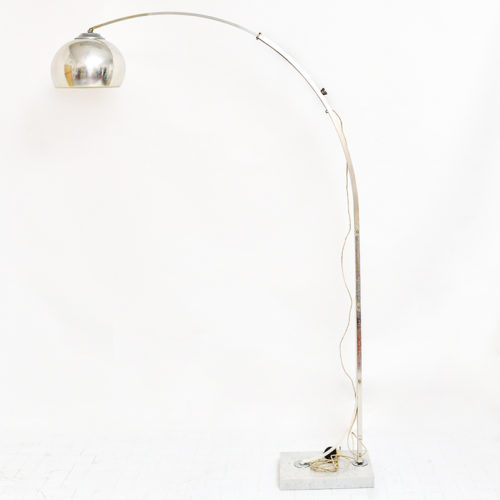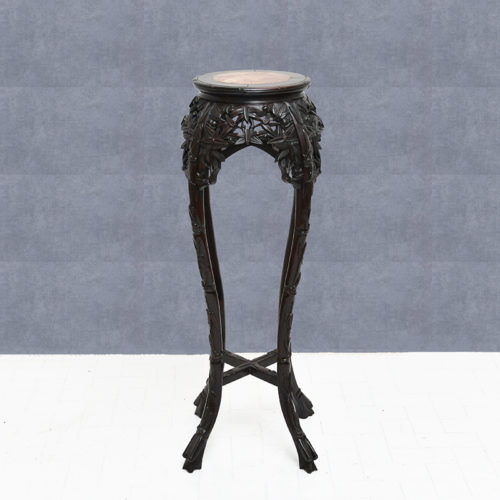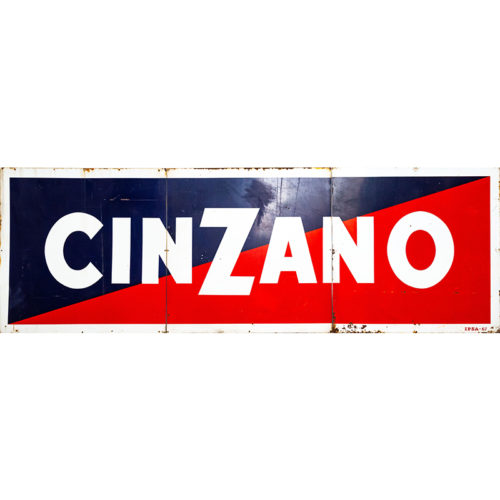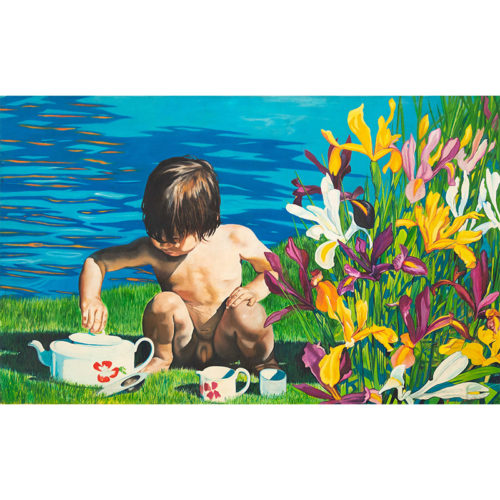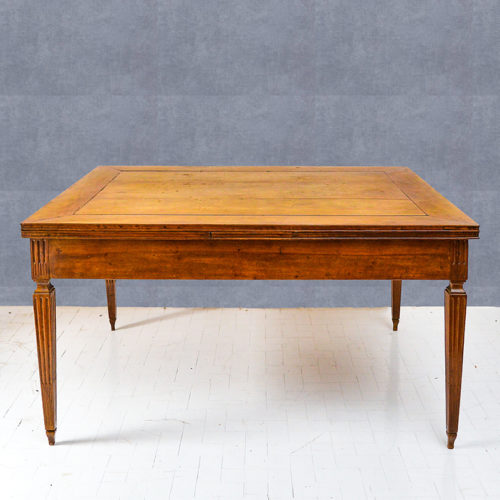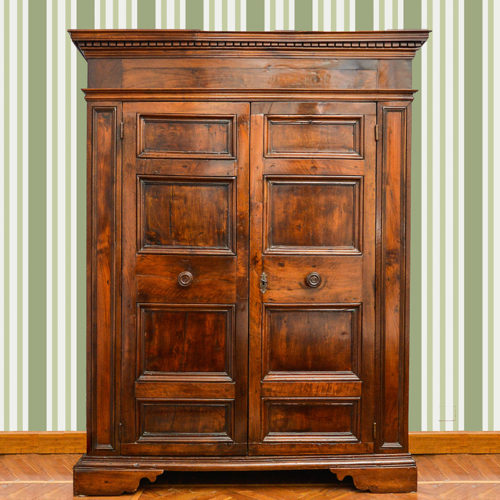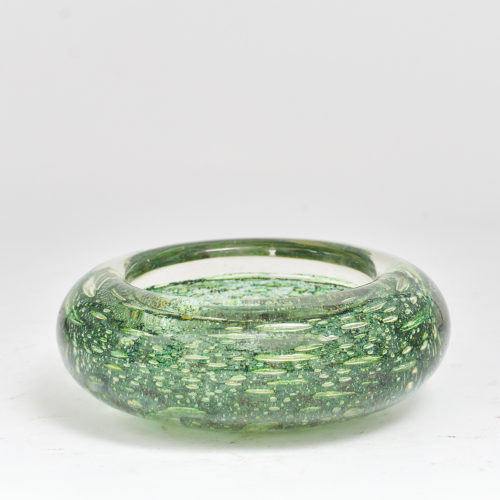Piedmontese flap in Louis XVI style in cherry wood, original from the end of the 18th century, with contemporary handles.
-
Out of stock
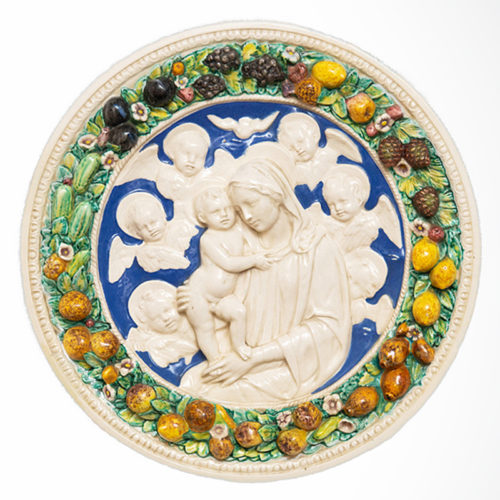 Period: 1920s Measurements: Ø 63 x P 6.5 cmRound painted ceramic Della Robbia, depicting the Madonna with child and angels, dating back to the 1920s
Period: 1920s Measurements: Ø 63 x P 6.5 cmRound painted ceramic Della Robbia, depicting the Madonna with child and angels, dating back to the 1920s -
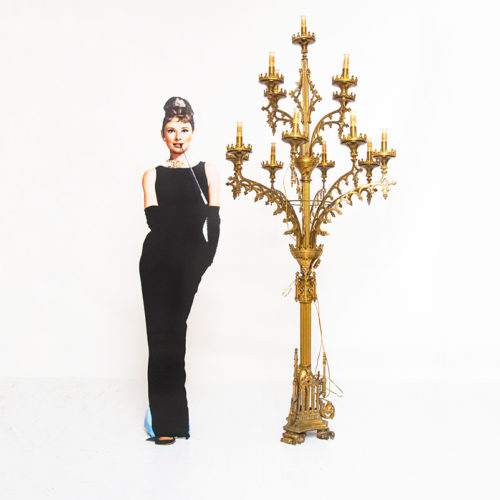 Large gilded bronze candlestick, dated 24 May 1908. On the base bears an inscription commemorating the beatification of Maddalena Sofia Barat (Joigny, 12 December 1779 - Paris, 25 May 1865) who was a French religious, founder of the Society of the Sacred Heart of Jesus. Date of beatification: May 24, 1908. (Template height m 1.66)Period: May 24, 1908 Measurements: H 210 x Ø 90 cm
Large gilded bronze candlestick, dated 24 May 1908. On the base bears an inscription commemorating the beatification of Maddalena Sofia Barat (Joigny, 12 December 1779 - Paris, 25 May 1865) who was a French religious, founder of the Society of the Sacred Heart of Jesus. Date of beatification: May 24, 1908. (Template height m 1.66)Period: May 24, 1908 Measurements: H 210 x Ø 90 cm -
Out of stock
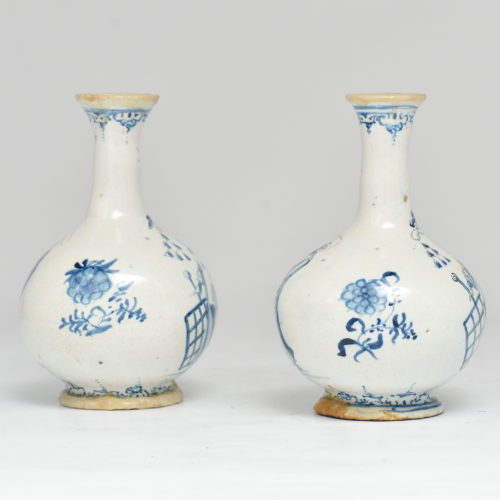 Pair of ointment containers, Savona, in good condition, dating back to the 18th century. In 1641 the Genoese Senate granted to the Grosso factory in Albisola the privilege of marking the ceramics with the symbol of the lighthouse of Genoa, the lantern. Between the end of the seventeenth and the beginning of the eighteenth century, again with the permission of the Genoese Senate, the lantern became the symbol of the Chiodo-Peirano, society of Savona. The Chiodos, after 1738, who remained the sole owners of the factory, continued to mark their ceramics with the lantern until 1782, the year of the transfer of the factory to the company Pittamiglio-Astengo-Carlevarino, which in turn gave up the business in 1786. Epoca: '700 Measurements: H 18 x Ø 12 cm
Pair of ointment containers, Savona, in good condition, dating back to the 18th century. In 1641 the Genoese Senate granted to the Grosso factory in Albisola the privilege of marking the ceramics with the symbol of the lighthouse of Genoa, the lantern. Between the end of the seventeenth and the beginning of the eighteenth century, again with the permission of the Genoese Senate, the lantern became the symbol of the Chiodo-Peirano, society of Savona. The Chiodos, after 1738, who remained the sole owners of the factory, continued to mark their ceramics with the lantern until 1782, the year of the transfer of the factory to the company Pittamiglio-Astengo-Carlevarino, which in turn gave up the business in 1786. Epoca: '700 Measurements: H 18 x Ø 12 cm -
Out of stock
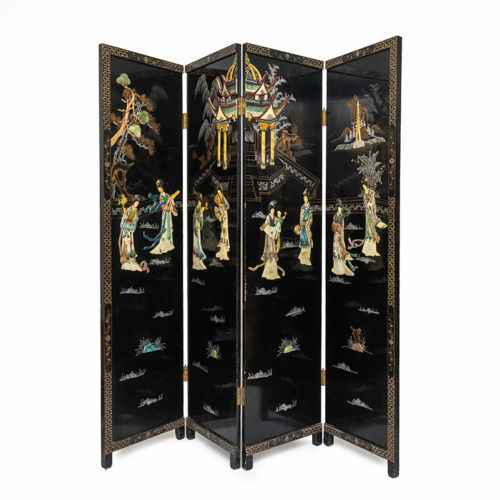 Period: 1950s Measurements: H 183 x L 182 P closed 12 / P open 3 cm (L door 46)50s Japanese separè, one side decorated with painted applications and decorations.
Period: 1950s Measurements: H 183 x L 182 P closed 12 / P open 3 cm (L door 46)50s Japanese separè, one side decorated with painted applications and decorations. -
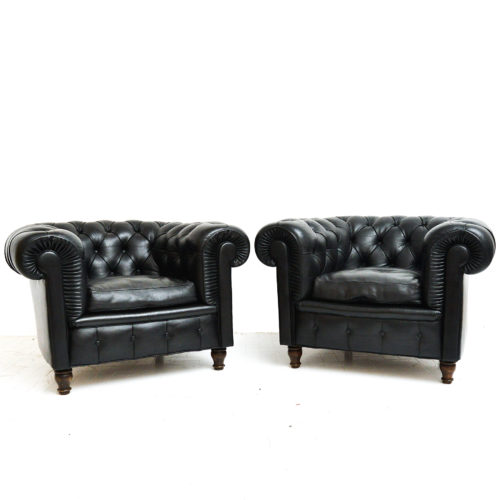 Period: Design 1912 Measurements: H seat 44 x H 67 x L 102 x P 94 cmPair of Chester Frau armchairs (Design Renzo Frau), original and branded. The Chester sofa refers to the classic model of Edwardian England, taken up by Renzo Frau in the first catalog of 1912, inspired by the sofas and armchairs that populated English clubs and country houses in those years. Load-bearing structure in seasoned beech, hand-tied biconical steel springs, jute belts, rubberized vegetable hair and hand-shaped vegetable hair. The seat cushions are in goose down. The upholstery is in Frau leather with capitonnée work done entirely by hand. A row of nails covered in leather finishes the back.
Period: Design 1912 Measurements: H seat 44 x H 67 x L 102 x P 94 cmPair of Chester Frau armchairs (Design Renzo Frau), original and branded. The Chester sofa refers to the classic model of Edwardian England, taken up by Renzo Frau in the first catalog of 1912, inspired by the sofas and armchairs that populated English clubs and country houses in those years. Load-bearing structure in seasoned beech, hand-tied biconical steel springs, jute belts, rubberized vegetable hair and hand-shaped vegetable hair. The seat cushions are in goose down. The upholstery is in Frau leather with capitonnée work done entirely by hand. A row of nails covered in leather finishes the back. -
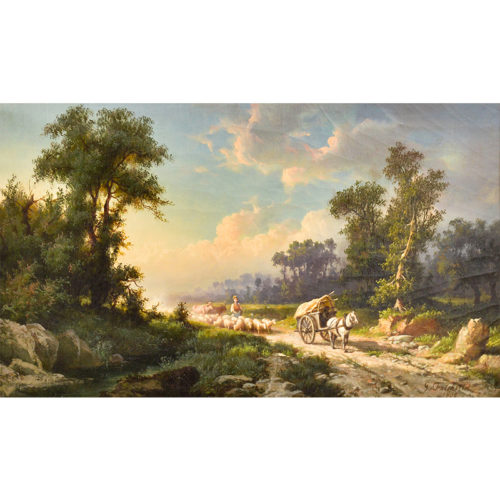 Period: 1899 Measurements: In frame H 56 x W 81.5 x D 7.5 / Canvas H 44 x L 68.5 cm"Return from pasture" - Oil on canvas by Giuseppe Falchetti (1843-1918), signed and dated lower right G. Falchetti 1899 Born in Caluso (Aosta), June 18, 1843, died in Turin on November 6, 1918. He attended the study of the Camino for five years, simultaneously studying the Flemish works preserved at the Pinacoteca di Torino. He specialized in painting still lives, and was commissioned by the Italian government, for twenty-seven years in row, to reproduce the best products of national viticulture. Hundreds of copies of his works were made and spread all over the world. He also treated the gorgeous landscapes. He had exhibited a Still Life in Turin in 1898.
Period: 1899 Measurements: In frame H 56 x W 81.5 x D 7.5 / Canvas H 44 x L 68.5 cm"Return from pasture" - Oil on canvas by Giuseppe Falchetti (1843-1918), signed and dated lower right G. Falchetti 1899 Born in Caluso (Aosta), June 18, 1843, died in Turin on November 6, 1918. He attended the study of the Camino for five years, simultaneously studying the Flemish works preserved at the Pinacoteca di Torino. He specialized in painting still lives, and was commissioned by the Italian government, for twenty-seven years in row, to reproduce the best products of national viticulture. Hundreds of copies of his works were made and spread all over the world. He also treated the gorgeous landscapes. He had exhibited a Still Life in Turin in 1898. -
Out of stock
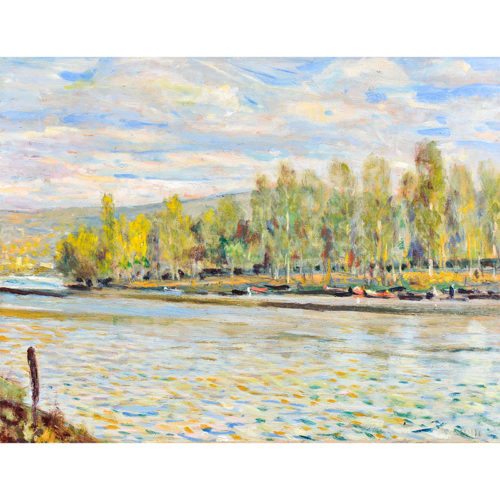 Period: September 14, 1943 Measurements: In frame H 52 x L 60 / Table H 33.5 x L 42 cm"This Arno with slow waters" - Oil on panel by Galileo Chini, signed on the lower right, bears the dedication on the back to his friend Giuseppe Orsi and the date 14 September 1943. CHINI GALILEO. Born on December 2, 1873 in Florence, died on August 23, 1956, then blind. As a boy he was a simple painter; at twenty he decided to study the ancient and modern masters. In 1899 with some friends he created "The Art of Ceramics", managing to give this feat a new physiognomy to Italian majolica. He has participated in numerous and important exhibitions in Paris, Leningrad, Barcelona, Saint-Louis, Brussels and in Italian exhibitions, including the Venice Biennials from IV to XVII. Among the various decoration works, those of the buildings of the Cassa di Risparmio of Pistoia, Arezzo and Florence, as well as those of the Throne Palace in Bangkok (Siam), and among the easel works: Quiete; The triumph; The Baptist; Icarus; The game and the fat tempera painting depicting The Last Supper, in which it reaffirms its qualities as a strong symbolist decorator of daring conceptions and a lovable coloring, which achieves remarkable effects with simplicity of means and with natural spontaneity. In 1932 he held a personal exhibition in Milan, at the Pesaro Gallery, with still life paintings, flowers, figures and Parisian landscapes or on the banks of the Arno. He was a teacher of decoration at the Academy of Florence.
Period: September 14, 1943 Measurements: In frame H 52 x L 60 / Table H 33.5 x L 42 cm"This Arno with slow waters" - Oil on panel by Galileo Chini, signed on the lower right, bears the dedication on the back to his friend Giuseppe Orsi and the date 14 September 1943. CHINI GALILEO. Born on December 2, 1873 in Florence, died on August 23, 1956, then blind. As a boy he was a simple painter; at twenty he decided to study the ancient and modern masters. In 1899 with some friends he created "The Art of Ceramics", managing to give this feat a new physiognomy to Italian majolica. He has participated in numerous and important exhibitions in Paris, Leningrad, Barcelona, Saint-Louis, Brussels and in Italian exhibitions, including the Venice Biennials from IV to XVII. Among the various decoration works, those of the buildings of the Cassa di Risparmio of Pistoia, Arezzo and Florence, as well as those of the Throne Palace in Bangkok (Siam), and among the easel works: Quiete; The triumph; The Baptist; Icarus; The game and the fat tempera painting depicting The Last Supper, in which it reaffirms its qualities as a strong symbolist decorator of daring conceptions and a lovable coloring, which achieves remarkable effects with simplicity of means and with natural spontaneity. In 1932 he held a personal exhibition in Milan, at the Pesaro Gallery, with still life paintings, flowers, figures and Parisian landscapes or on the banks of the Arno. He was a teacher of decoration at the Academy of Florence. -
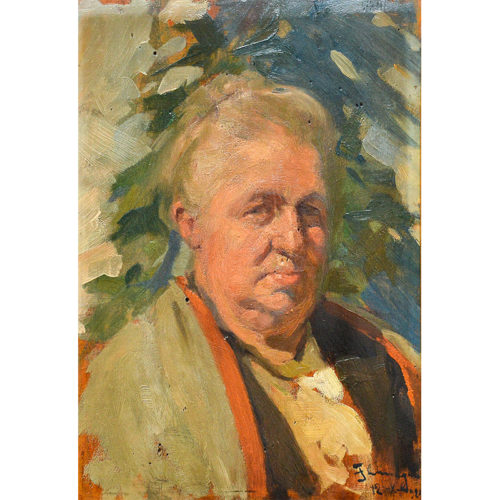 Period: 12-10-1924 Measurements: In frame H 46 x L 36 x P 4 cm / Table H 33 x L 23 cm"Portrait of an old woman" - Oil on panel by Filippo Omegna (1881-1948). Signed and dated on the lower right corner. Born in Turin on 11 March 1881, died in Montaldo di Mondovì on 1 September 1948. He was among the best pupils of Giacomo Grosso, from whom he was appointed while very young as teacher of nude and costume history at the Academy Albertina of Turin. Full Professor of Figure, in the same Academy, from 1932 until his death.
Period: 12-10-1924 Measurements: In frame H 46 x L 36 x P 4 cm / Table H 33 x L 23 cm"Portrait of an old woman" - Oil on panel by Filippo Omegna (1881-1948). Signed and dated on the lower right corner. Born in Turin on 11 March 1881, died in Montaldo di Mondovì on 1 September 1948. He was among the best pupils of Giacomo Grosso, from whom he was appointed while very young as teacher of nude and costume history at the Academy Albertina of Turin. Full Professor of Figure, in the same Academy, from 1932 until his death. -
Out of stock
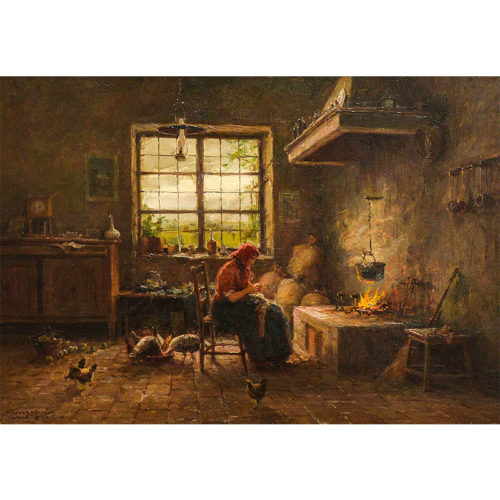 Period: 30s / 40s Measurements: In frame H 54 x L 66 / Paper H 32 x L 44.5 cm"Interior with stapler at the fireplace" - Oil on panel by Giuseppe Gheduzzi (1889-1957). Born in Crespellano (Bologna) on May 12, 1889, he lived in Turin where he died on May 21, 1957. He learned the basics of art from his father Ugo, then attended the Accademia Albertina, as pupil of Andrea Marchisio and Paolo Gaidano, for only three years, because he was forced to help his father in the scenography works. He was a skilled landscape painter. It began in Vignola in 1907 with an alpine landscape. He held several solo exhibitions and took part in many exhibitions. He participated in the events of the Promotrice alle Belle Arti in Turin for twenty years in row (awarded with a gold medal) and in the circle of artists in Turin. Personal holds at the Bolzani Gallery in Milan; at the Galleria A. Garabello in Biella; at Galleri Fogliato and Lombardi Gallery in Turin.
Period: 30s / 40s Measurements: In frame H 54 x L 66 / Paper H 32 x L 44.5 cm"Interior with stapler at the fireplace" - Oil on panel by Giuseppe Gheduzzi (1889-1957). Born in Crespellano (Bologna) on May 12, 1889, he lived in Turin where he died on May 21, 1957. He learned the basics of art from his father Ugo, then attended the Accademia Albertina, as pupil of Andrea Marchisio and Paolo Gaidano, for only three years, because he was forced to help his father in the scenography works. He was a skilled landscape painter. It began in Vignola in 1907 with an alpine landscape. He held several solo exhibitions and took part in many exhibitions. He participated in the events of the Promotrice alle Belle Arti in Turin for twenty years in row (awarded with a gold medal) and in the circle of artists in Turin. Personal holds at the Bolzani Gallery in Milan; at the Galleria A. Garabello in Biella; at Galleri Fogliato and Lombardi Gallery in Turin. -
Out of stock
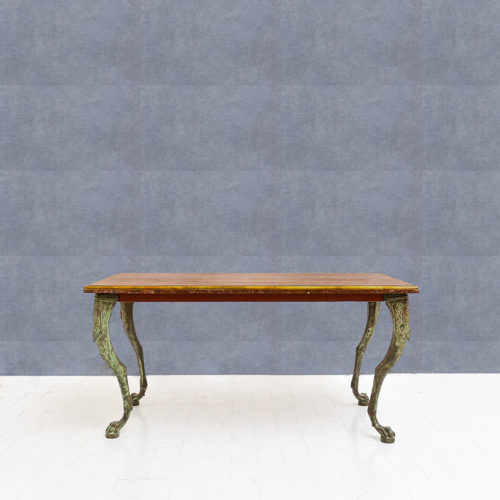 Period: 1920s Measurements: H 49.5 x L 100.5 x P 50 cmPeculiar coffee table, four-legged bronze base, greyhound paw shape, masks and decorations. Marble top.
Period: 1920s Measurements: H 49.5 x L 100.5 x P 50 cmPeculiar coffee table, four-legged bronze base, greyhound paw shape, masks and decorations. Marble top. -
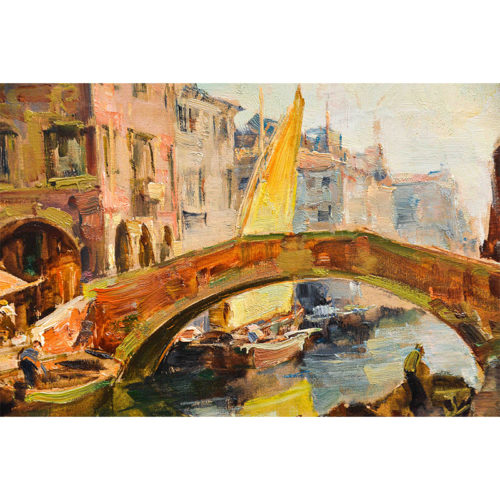 Period: 1940s / 50s Measurements: H 57 x L 67 x P 4 / Canvas H 41 x L 51.5 cm"Ponte dal Vigo, Canal Vena, Chioggia" - Oil on canvas by Angelo Brombo (1893-1962), dating back to the 1940s / 1950s. Signed on the lower right. BROMBO ANGELO. Born in Chioggia on January 5, 1893, he moved to Venice. He participated in the exhibitions in Venice Rome, Turin, Naples and other minor ones, from the Veneto region, with flattering success, and also in Rome in 1926 at the Mostra d'Arte Marinara, in Milan the following year, at the Primavera; in Bologna, Como, Rovigo; again in Rome; in Milan at the Mostra Peschereccia in 1939, where he obtained the gold medal of the Ministry of Agriculture. He has held solo shows in many Italian cities, receiving praise from the public and flattering judgments from critics for his personal, moving evidence in the marine theme. He has many works in private collections and among them: Polichromie chioggiotte (Conte Molini collection of Venice), Sails, Vita chioggiotta, La riva dei Rigattieri, Gray days, Shopping on board, Campo del Duomo (Pennasilico collection). Other works in public collections: The Mausoleum of Diocletian in Split (Capitoline Museum in Rome), Ruins of Nona (Collez. Comunale di Perugia), La Vela (Municipality of Cavarzere).
Period: 1940s / 50s Measurements: H 57 x L 67 x P 4 / Canvas H 41 x L 51.5 cm"Ponte dal Vigo, Canal Vena, Chioggia" - Oil on canvas by Angelo Brombo (1893-1962), dating back to the 1940s / 1950s. Signed on the lower right. BROMBO ANGELO. Born in Chioggia on January 5, 1893, he moved to Venice. He participated in the exhibitions in Venice Rome, Turin, Naples and other minor ones, from the Veneto region, with flattering success, and also in Rome in 1926 at the Mostra d'Arte Marinara, in Milan the following year, at the Primavera; in Bologna, Como, Rovigo; again in Rome; in Milan at the Mostra Peschereccia in 1939, where he obtained the gold medal of the Ministry of Agriculture. He has held solo shows in many Italian cities, receiving praise from the public and flattering judgments from critics for his personal, moving evidence in the marine theme. He has many works in private collections and among them: Polichromie chioggiotte (Conte Molini collection of Venice), Sails, Vita chioggiotta, La riva dei Rigattieri, Gray days, Shopping on board, Campo del Duomo (Pennasilico collection). Other works in public collections: The Mausoleum of Diocletian in Split (Capitoline Museum in Rome), Ruins of Nona (Collez. Comunale di Perugia), La Vela (Municipality of Cavarzere). -
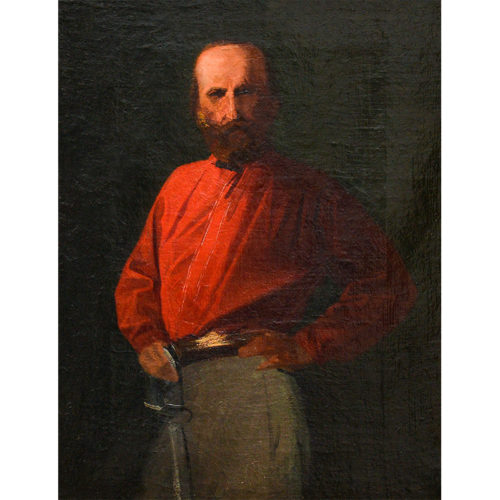 Period: 19th century Measurements: H 50 x L 41 x P 4.5 / Canvas H 39 x L 31 cm"Garibaldi" - Oil on canvas by Teofilo Patini (1840-1906) PATINI TEOFILO. Born in Castel di Sangro (L'Aquila) on May 5, 1840, died in Naples on November 16, 1906. He moved to Naples at a very young age, after graduating in Fine Arts; he enrolled at the Institute of Fine Arts, where Filippo Palizzi was teaching at the time. During the courses he easily won several prizes and finally obtained a pensioner to go to Rome, where he studied deeply the ancient masters and in particular those of the seventeenth century. He also was strongly influenced from Dutch paintings, but, above all, it was the Meissonnier who conquered him. He first dealt, for a short period of time, with the historical picture; then, with his sensitive and scornful soul, as an attentive observer of the events of human life, he gave himself to social painting, expressed with a strong and meticulous verism. His masterpiece is L'erede, which was exhibited in Milan in 1881 and is now found in the Gallery of Modern Art in Rome with Spade and Milk, exhibited in Turin in 1884. Other important paintings of his are: Il Parmigianino; The sack of Rome, of the Municipality of Naples; Art and freedom; Salvator Rosa's studio, exhibited in Turin in 1880 and in Vienna; Every good boot becomes a slipper; The first riding lesson, which is owned by the baritone Titta Ruffo; Pack animals, sent to Venice in 1887; Rocky landscape, in the M.O. collection of Milan; The riding lesson, in the Borgogna Museum of Vercelli; The country doctor; Belly and heart; The company of death: After defeat; The good ones; The notables of my country; The eagle; The caralluccio; Return to the sheepfold; The chain. Patini also tried, with less success, the sacred subject, and the paintings are remembered in this regard: Gloria del Sacramento; The temptations of Saint Anthony; Christ in the garden; The Redeemer; Christ raises the widow's son; The Annunziata; Il Purgatorio: The Crucifix; The Guardian Angel; Sant'Antonio di Padova; San Carlo Borromeo. There are also the sketches for the decorations of the Aula Magna of the University of Naples (work that, for the artist's death, remained unfinished), and the frescoes in the hall of the City Council of the same city. His students include M. Dragonetti Cappelli, E. Rubei, Vittor Scarselli.
Period: 19th century Measurements: H 50 x L 41 x P 4.5 / Canvas H 39 x L 31 cm"Garibaldi" - Oil on canvas by Teofilo Patini (1840-1906) PATINI TEOFILO. Born in Castel di Sangro (L'Aquila) on May 5, 1840, died in Naples on November 16, 1906. He moved to Naples at a very young age, after graduating in Fine Arts; he enrolled at the Institute of Fine Arts, where Filippo Palizzi was teaching at the time. During the courses he easily won several prizes and finally obtained a pensioner to go to Rome, where he studied deeply the ancient masters and in particular those of the seventeenth century. He also was strongly influenced from Dutch paintings, but, above all, it was the Meissonnier who conquered him. He first dealt, for a short period of time, with the historical picture; then, with his sensitive and scornful soul, as an attentive observer of the events of human life, he gave himself to social painting, expressed with a strong and meticulous verism. His masterpiece is L'erede, which was exhibited in Milan in 1881 and is now found in the Gallery of Modern Art in Rome with Spade and Milk, exhibited in Turin in 1884. Other important paintings of his are: Il Parmigianino; The sack of Rome, of the Municipality of Naples; Art and freedom; Salvator Rosa's studio, exhibited in Turin in 1880 and in Vienna; Every good boot becomes a slipper; The first riding lesson, which is owned by the baritone Titta Ruffo; Pack animals, sent to Venice in 1887; Rocky landscape, in the M.O. collection of Milan; The riding lesson, in the Borgogna Museum of Vercelli; The country doctor; Belly and heart; The company of death: After defeat; The good ones; The notables of my country; The eagle; The caralluccio; Return to the sheepfold; The chain. Patini also tried, with less success, the sacred subject, and the paintings are remembered in this regard: Gloria del Sacramento; The temptations of Saint Anthony; Christ in the garden; The Redeemer; Christ raises the widow's son; The Annunziata; Il Purgatorio: The Crucifix; The Guardian Angel; Sant'Antonio di Padova; San Carlo Borromeo. There are also the sketches for the decorations of the Aula Magna of the University of Naples (work that, for the artist's death, remained unfinished), and the frescoes in the hall of the City Council of the same city. His students include M. Dragonetti Cappelli, E. Rubei, Vittor Scarselli. -
Out of stock
 Period: Second half of the 18th century Measurements: H 83 x L 72 x P 4 / Canvas H 71.5 x L 51 cmPair of ovals canvasses depicting two portraits of aristocrats, man and woman, dating back to the second half of the eighteenth century, oil on canvas in a contemporary frame, restored and reintelated.
Period: Second half of the 18th century Measurements: H 83 x L 72 x P 4 / Canvas H 71.5 x L 51 cmPair of ovals canvasses depicting two portraits of aristocrats, man and woman, dating back to the second half of the eighteenth century, oil on canvas in a contemporary frame, restored and reintelated. -
Out of stock
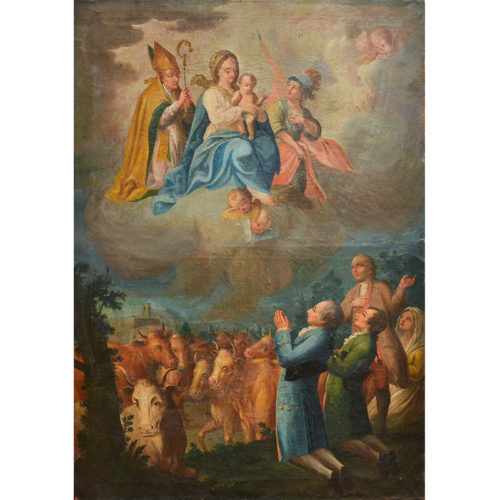 Period: 18th century Measurements: H 101 x L 71.5 x P 3 cm"Prayer" - Oil on canvas with religious scene, dating back to the 18th century
Period: 18th century Measurements: H 101 x L 71.5 x P 3 cm"Prayer" - Oil on canvas with religious scene, dating back to the 18th century -
Out of stock
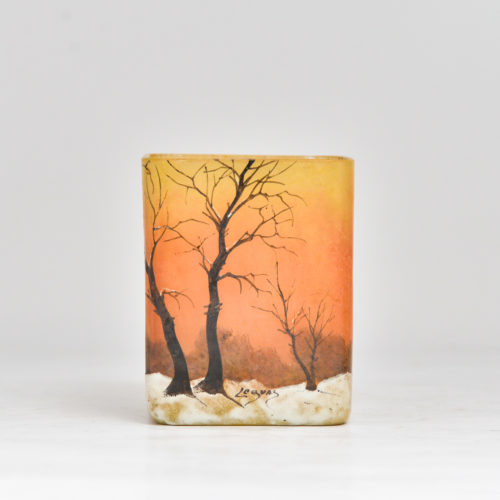 Period: Early 1900s Measurements: H 11.5 x L 9.5 x P 9.5 cmRefined small Legras vase with a square base in etched glass, decorated with a winter landscape, signed on the lower center, in excellent condition.
Period: Early 1900s Measurements: H 11.5 x L 9.5 x P 9.5 cmRefined small Legras vase with a square base in etched glass, decorated with a winter landscape, signed on the lower center, in excellent condition. -
Out of stock
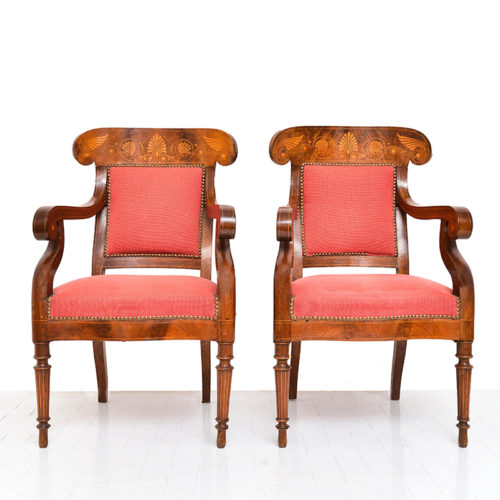 Period: around 1840 Measurements: H 100 x L 57 x P 56 x H seat 45 cmPair of Charles X armchairs, in walnut, inlaid in boxwood, dating back to the 1840s, red fabric in good condition, to be re-upholstered.
Period: around 1840 Measurements: H 100 x L 57 x P 56 x H seat 45 cmPair of Charles X armchairs, in walnut, inlaid in boxwood, dating back to the 1840s, red fabric in good condition, to be re-upholstered.
